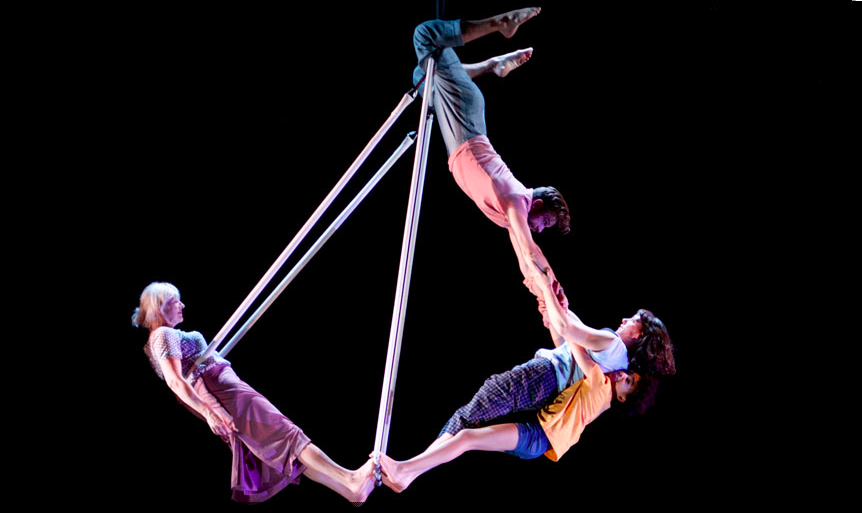Review from: St Stephen’s Theatre, Edinburgh Festival Fringe; 15th August 2019
Aerial theatre company Ockham’s Razor was formed in 2004 and, since then, has created a collection of successful shows using custom-made unusual apparatus, including Tipping Point which won the Total Theatre & Jackson’s Lane Award for Circus at Edinburgh Festival 2016. Their new show, This Time, which premiered in May 2019, has just completed a run at St Stephens Theatre as part of the Edinburgh Fringe. It is quite different from Tipping Point, using text to deliver stories from a ‘mixed age’ cast.
This Time creates a space for contemplation. The production feels dream-like at times, shifting in and out of reality. The contrast of some of the heart-wrenchingly honest stories with the hypnotic choreography allows us time to reflect on our relationships with ourselves and others. The show uses a four person cast of 40-year olds Charlotte Mooney and Alex Harvey (both founding members of Ockham’s Razor, with Tina Koch) alongside Lee Carter (age 60) and Faith Fahy (age 13). It begins with all four on an apparatus that consists of a white metal frame and a white looped rope. I read this as a family navigating their relationships, as they negotiate the space, supporting and balancing each other. It is tender and intricate and sets us up well for the rest of the show.
Although historically circus has been a family affair, in contemporary circus it is not often you would find such an age range in a show. After watching the show I met with Charlotte Mooney, performer and joint Artistic Director, to discuss the reasoning behind these choices. ‘It’s becoming quite professionalised and so the expectation of very high skill means you’re getting people in their 20’s and 30’s in their peak’.
Mooney talks about the benefits of having a range of ages: ‘It’s been a complete and utter joy. Everyone gets on really well and everyone has such different perspectives to feed in. The wisdom of Lee and Faith has been amazing’.
The variety of experience is revealed in the stories that they tell. The breadth of topics that they cover mean that everyone in the audience can relate to something and by drawing links between the stories they can be seen in a wider context. This reminds us of the value in interacting with people of all ages and, in one scene where they all dance playfully together, I am reminded of the cultural anomaly of a wedding, where the youngest through to the oldest all share the dancefloor.
Charlotte and Alex have a young daughter together. When Charlotte was pregnant she completed a 3 month course in storytelling because she knew she would not be performing physically for a while and wanted to explore using text. She tells me that the craft of storytelling is quite specific, it is an oral craft, so the script is non-written. ‘It’s storytelling not acting which is very different,’ she explained. ‘I found it a similar performance style to circus in that you are yourself and also not yourself, and you jump between the two.’ This influence sets them apart from other contemporary circuses using a confessional style. The sincerity of the anecdotes comes across and it’s easy to believe that they are genuine.
Charlotte described how, especially after having a child, she grew frustrated with the way that love is often portrayed in art as one dimensional. She said that she wanted to reflect ‘intense, raw, deep love, that is not sentimental or floofy at all, it is really transformative’. This is particularly evident in her doubles piece with Alex. He is wearing a harness hidden within his clothes and is cleverly braced with wires so that his hips become the rotation point. This essentially means that they appear to be two bodies, suspended in space, with nothing but each other holding them up. The mutual support and trust they show indicates a relationship that is about strength and unity, as opposed to ‘romance’ (And, along with the aerial frame apparatus, is a fun echo of the company’s early work Memento Mori – Ed.).
As an aerialist I am particularly captivated by all of the innovative rigging. They do not use anything that is clearly distinguishable and this is intentional; ‘We always tried to make circus equipment that didn’t look like circus equipment, so it functions as a piece of set or sculpture’. This allows the audience the freedom to imagine their own contexts for the equipment; for me, representing the passing of time and personal transformation among other things.
The show proposes we consider how much as a society we tend to underestimate both younger and older people. It highlights the defining moments that shape us and the profound impact our relationships with others can have. It is an important reminder that our identities are not fixed and we are always evolving.




